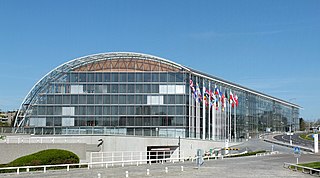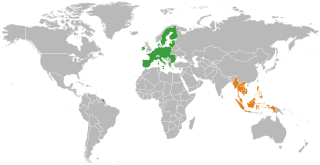
The European Bank for Reconstruction and Development (EBRD) is an international financial institution founded in 1991. As a multilateral developmental investment bank, the EBRD uses investment as a tool to build market economies. Initially focused on the countries of the former Eastern Bloc it expanded to support development in more than 30 countries from Central Europe to Central Asia. Similar to other multilateral development banks, the EBRD has members from all over the world, with the biggest single shareholder being the United States, but only lends regionally in its countries of operations. Headquartered in London, the EBRD is owned by 71 countries and two European Union institutions, the newest shareholder being Algeria since October 2021. Despite its public sector shareholders, it invests in private enterprises, together with commercial partners.

The European Investment Bank (EIB) is the European Union's development bank and is owned by the EU Member States. It is one of the largest supranational lenders in the world. The EIB finances and invests both through equity and debt solutions projects that achieve the policy aims of the European Union through loans, guarantees and technical assistance.

The Cotonou Agreement is a treaty between the European Union and the African, Caribbean and Pacific Group of States. It was signed in June 2000 in Cotonou, Benin's largest city, by 78 ACP countries and the then fifteen Member States of the European Union. It entered into force in 2003 and was subsequently revised in 2005 and 2010.

The Tuchola Forest, also known as Tuchola Pinewoods or Tuchola Conifer Woods, is a large forest complex near the town of Tuchola in northern Poland, which lies between the Brda and Wda Rivers, within the Gdańsk Pomerania region. The largest towns in the area are Czersk and Tuchola.

The regional policy of the European Union (EU), also referred as Cohesion Policy, is a policy with the stated aim of improving the economic well-being of regions in the European Union and also to avoid regional disparities. More than one third of the EU's budget is devoted to this policy, which aims to remove economic, social and territorial disparities across the EU, restructure declining industrial areas and diversify rural areas which have declining agriculture. In doing so, EU regional policy is geared towards making regions more competitive, fostering economic growth and creating new jobs. The policy also has a role to play in wider challenges for the future, including climate change, energy supply and globalisation.

The European Structural and Investment Funds are financial tools governed by a common rulebook, set up to implement the regional policy of the European Union, as well as the structural policy pillars of the Common Agricultural Policy and the Common Fisheries Policy. They aim to reduce regional disparities in income, wealth and opportunities. Europe's poorer regions receive most of the support, but all European regions are eligible for funding under the policy's various funds and programmes. The current framework is set for a period of seven years, from 2021 to 2027.
Social innovations are new social practices that aim to meet social needs in a better way than the existing solutions, resulting from - for example - working conditions, education, community development or health. These ideas are created with the goal of extending and strengthening civil society. Social innovation includes the social processes of innovation, such as open source methods and techniques and also the innovations which have a social purpose—like activism, crowdfunding, time-based currency, telehealth, cohousing, virtual volunteering, microcredit, or distance learning. There are many definitions of social innovation, however, they usually include the broad criteria about social objectives, social interaction between actors or actor diversity, social outputs, and innovativeness. Different definitions include different combinations and different number of these criteria. Transformative social innovation not only introduces new approaches to seemingly intractable problems, but is successful in changing the social institutions that created the problem in the first place.

The European Social Fund Plus (ESF+) is one of the European Structural and Investment Funds (ESIFs), which are dedicated to improving social cohesion and economic well-being across the regions of the Union. The funds are redistributive financial instruments that support cohesion within Europe by concentrating spending on the less-developed regions.
Rural community development encompasses a range of approaches and activities that aim to improve the welfare and livelihoods of people living in rural areas. As a branch of community development, these approaches pay attention to social issues particularly community organizing. This is in contrast to other forms of rural development that focus on public works and technology.
Interreg is a series of programmes to stimulate cooperation between regions in and out of the European Union (EU), funded by the European Regional Development Fund. The first Interreg started in 1989. Interreg IV covered the period 2007–2013. Interreg V (2014–2020) covers all 27 EU member states, the EFTA countries, six accession countries and 18 neighbouring countries. It has a budget of EUR 10.1 billion, which represents 2.8% of the total of the European Cohesion Policy budget. Since the non EU countries don't pay EU membership fee, they contribute directly to Interreg, not through ERDF.
Water supply and sanitation in Indonesia is characterized by poor levels of access and service quality. Almost 30 million people lack access to an improved water source and more than 70 million of the country's 264 million population has no access to improved sanitation. Only about 2% of people have access to sewerage in urban areas; this is one of the lowest in the world among middle-income countries. Water pollution is widespread on Bali and Java. Women in Jakarta report spending US$11 per month on boiling water, implying a significant burden for the poor.
EQUAL was a Community Initiative within the European Social Fund of the European Union. It concerned “transnational co-operation to promote new means of combating all forms of discrimination and inequalities in connection with the labour market”. It ran from 2001 till 2007 with a budget of some €3 billion of EU resources, matched by a similar sum from national resources.

The drinking water supply and sanitation sector in Ghana faces a number of challenges, including very limited access to sanitation, intermittent supply, high water losses, low water pressure, and pollution. Since 1994, the sector has been gradually reformed through the creation of an autonomous regulatory agency, introduction of private sector participation, decentralization of the rural supply to 138 districts and increased community participation in the management of rural water systems.

The ASEAN–European Union relations are the bilateral foreign relations between the two organisations; the European Union (EU), and the Association of South-East Asian Nations (ASEAN). EU and ASEAN have been interacting with each other on the economic, trade, and political levels for more than four decades. The partnership between the EU and ASEAN dates back to 1972, when the EU established ties with ASEAN. The EU became an ASEAN Dialogue Partner in 1977.

Water supply and sanitation in Senegal is characterized by a relatively high level of access compared to most of Sub-Saharan Africa. One of its interesting features is a public-private partnership (PPP) that has operatedin Senegal since 1996, with Senegalaise des Eaux (SDE), a subsidiary of Saur International, as the private partner. It does not own the water system but manages it on a 10-year lease contract with the Senegalese government. Between 1996 and 2014, water sales doubled to 131 million cubic meters per year and the number of household connections increased by 165% to more than 638,000. According to the World Bank, "the Senegal case is regarded as a model of public-private partnership in sub-Saharan Africa". Another interesting feature is the existence of a national sanitation company in charge of sewerage, wastewater treatment and stormwater drainage, which has been modeled on the example of the national sanitation company of Tunisia and is unique in Sub-Saharan Africa.

Water supply and sanitation in Tanzania is characterised by: decreasing access to at least basic water sources in the 2000s, steady access to some form of sanitation, intermittent water supply and generally low quality of service. Many utilities are barely able to cover their operation and maintenance costs through revenues due to low tariffs and poor efficiency. There are significant regional differences and the best performing utilities are Arusha and Tanga.

European Union–Pakistan relations are the international relations between the common foreign policy and trade relations of the European Union and the Islamic Republic of Pakistan.

Although access to water supply and sanitation in sub-Saharan Africa has been steadily improving over the last two decades, the region still lags behind all other developing regions. Access to improved water supply had increased from 49% in 1990 to 68% in 2015, while access to improved sanitation had only risen from 28% to 31% in that same period. Sub-Saharan Africa did not meet the Millennium Development Goals of halving the share of the population without access to safe drinking water and sanitation between 1990 and 2015. There still exists large disparities among sub-Saharan African countries, and between the urban and rural areas. The MDGs set International targets to reduce inadequate Water Sanitation and Hygiene (WASH) coverage and now new targets exist under the Sustainable Development Goals. The MDGs called for halving the proportion of the population without access to adequate water and sanitation, whereas the SDGs call for universal access, require the progressive reduction of inequalities, and include hygiene in addition to water and sanitation. Particularly, Sustainable Development Goal SDG6 focuses on ensuring availability and sustainable management of water and sanitation for all.

Cross-border cooperation is the collaboration between adjacent areas across borders. In the European Union this is one of the forms of territorial cooperation. The European model is very diverse with cooperation between border regions or municipalities, or through specific cooperation structures. These structures are usually composed by public authorities from different countries organized in working communities, euroregions or EGTCs.
AEIDL is the European Association for Innovation in Local Development. It adopted this new name in June 2022, prior to which it was called the European Association for Information on Local Development/Association Européenne pour l'Information sur le Développement Local.














